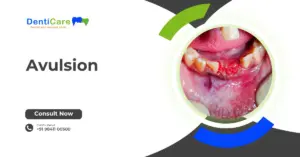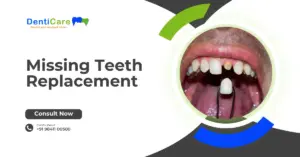What is Avulsion?
Also known as, Knocked out teeth.
It is when the tooth is completely out of the socket due to any accident or any injury. The teeth along with the surrounding tissues are affected.
It is a dental emergency and the result of the treatment is dependent on the actions leading to the treatment. It is important to be informed and to have a good knowledge about what to do in case of dental emergencies.

Case Report
Patient named Mr.Murugan , of age 32 years reported to the clinic with a lower tooth which fell out.
Nature of the Incident: Mr. Murugan was trying to pull out a piece of metal wire with his teeth and in the process of removing the wire, unfortunately his teeth also came out. Patient immediately washed the teeth and wrapped it in a clean paper and came to the clinic within 20 minutes.
Investigation: Intraoral examination was done and an IOPA x-ray was taken.
Radiograph revealed that the tooth had periodontal loss, meaning bone weakening. The excessive force given to the tooth caused it to come out of the socket.
Treatment: Reinsertion of the fallen tooth and composite wire splinting it with adjacent tooth for anchorage.
Expected Outcome: Because of the bone loss present, long term survival of the tooth is very less. Prognosis is poor. This is an interim treatment until the patient to take decision regarding definitive treatment options. The survival of the tooth is based on the the amount of bone support left and vitality periodontal ligament cells , which holds the teeth.
The chances of the tooth staying in the socket without rejection is depends on the time it spends outside the mouth and the steps taken for the tooth to save it.
What to do in case of knocked out tooth?
STEP 1: Pick the teeth up only by the crown portion (white part) not by the root. If the socket is bleeding, gently bite down on handkerchief to stop the bleeding.
STEP 2: If it fell out during playing and is dirty, gently run it under milk or saline.
STEP 3: Immediately put the tooth in a proper storage media container. Storage media preferred is mentioned descending order – milk, saliva (spitting into a container), saline. Water is a poor storage medium but in case of nothing else, its better than leaving tooth to get dry. If not just keep the tooth inside your mouth.
STEP 4: RUSH TO YOUR DENTIST with the tooth container.
Early treatment can save the tooth and the expense for replacement of the teeth. Time is of the essence. As the time goes on, the possibility of the tooth getting reinserted also goes low. The cells surrounding the tooth slowly dies which won’t support the tooth to stay in the socket. Early reinsertion means the teeth might stick to the bone.
To read further about knocked out teeth, check this blog.
A knocked out tooth is a dental emergency. Immediately contact or visit us at Denticare Dental Clinic at Mogappair for your treatment.





